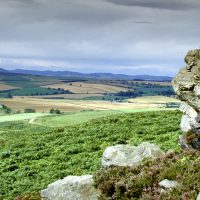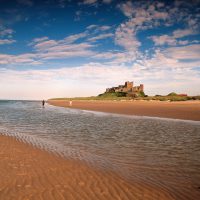The story of Northumberland has been one inextricably linked to bloodshed and combat and countless times in its history have the sounds of war have echoed throughout the hills. From the fierce Briton tribes who took on the might of Rome’s legions to the feuding clans of Reivers, Northumberland has played host to innumerable battles, skirmishes and sieges and its landscape is littered with the remnants of such conflicts. Lost and lonely hillforts share the area with squat and strong bastle houses, whilst monolithic and imposing castles stand tall and proud, commanding the approaches to Northumberland and to England beyond.
 The tale of modern Northumberland begins far back in the mists of history with the Votadini – a tribe of Britons who were the native inhabitants of the North. These peoples, who inhabited the land between the Tyne and the Firth of Forth, were the creators of the Northumbrian Tartan – the oldest known tartan in the world, with fragments having been found at Falkirk (Then within the lands of the Votadini) dating as far back as AD300. An incredible piece of history, Northumbrian Tartan is still made locally and is sold at many places around the county, including at Alnwick, Hexham and Corbridge. Whispers of our ancient ancestors can still be found around Northumberland; on windswept peaks their hillforts silently guard the moors, such as that at Yeavering Bell, a short drive from Wooler. There, one of the tribe’s main communities looked out over stunning views and the lines of a number of their forts can still be seen carved into the hillsides. For decades, they, and their kinsmen all across Albion, resisted the Roman war machine time and again, turning Britannia into one of Rome’s most troublesome provinces for centuries to come. Despite such tenacious resistance, ultimately it proved futile and in the years to come, the Votadini would be subjugated by Rome, to serve as a peaceful barrier state against the Picts of Caledonia.
The tale of modern Northumberland begins far back in the mists of history with the Votadini – a tribe of Britons who were the native inhabitants of the North. These peoples, who inhabited the land between the Tyne and the Firth of Forth, were the creators of the Northumbrian Tartan – the oldest known tartan in the world, with fragments having been found at Falkirk (Then within the lands of the Votadini) dating as far back as AD300. An incredible piece of history, Northumbrian Tartan is still made locally and is sold at many places around the county, including at Alnwick, Hexham and Corbridge. Whispers of our ancient ancestors can still be found around Northumberland; on windswept peaks their hillforts silently guard the moors, such as that at Yeavering Bell, a short drive from Wooler. There, one of the tribe’s main communities looked out over stunning views and the lines of a number of their forts can still be seen carved into the hillsides. For decades, they, and their kinsmen all across Albion, resisted the Roman war machine time and again, turning Britannia into one of Rome’s most troublesome provinces for centuries to come. Despite such tenacious resistance, ultimately it proved futile and in the years to come, the Votadini would be subjugated by Rome, to serve as a peaceful barrier state against the Picts of Caledonia.
In time though, the horns of war rang out again across the moors with the arrival of Ida and his Sons – warlords of the Saxons. With their arrival, Northumberland  was firmly placed in the history books. Indeed, it was from Northumberland itself that Britain’s first historian hailed – the Venerable Bede himself. Establishing their capital at Bamburgh, the Saxons eventually conquered the lands between the River Forth and the River Humber as one nation – the Kingdom of Northumbria. In the centuries that followed, Northumbria would grow to be the most powerful nation in all of the British Isles, with its rulers styled the Brytenwalda – The Kings of all the Britons. Old Northumbria can still be found all around the modern county of Northumberland. At Bewcastle, now in Cumbria but once part of Northumberland, one of the world’s best preserved early Saxon crosses remains in remarkably good condition. Indeed, just north of Churnsike Lodge itself, the Long Bar can be found. Thought to have been the original stone with which the cross was to have been made, it split before it reached Bewcastle and was abandoned out on the moors. At Yeavering again, the remains of a Royal Anglo-Saxon settlement, can be found, thought to have been the second capital of Northumbria. However, perhaps the most enduring symbol of Saxon Northumberland can be found at Lindisfarne – the birthplace of English Christianity and the first place to have been raided by the Viking Norsemen. With spectacular sea-views, a fascinating insight into the lives of early Saxon monks and perhaps just a little of the traditional Lindisfarne mead, a visit to Holy Island and a walk along its beautiful beaches is unforgettable.
was firmly placed in the history books. Indeed, it was from Northumberland itself that Britain’s first historian hailed – the Venerable Bede himself. Establishing their capital at Bamburgh, the Saxons eventually conquered the lands between the River Forth and the River Humber as one nation – the Kingdom of Northumbria. In the centuries that followed, Northumbria would grow to be the most powerful nation in all of the British Isles, with its rulers styled the Brytenwalda – The Kings of all the Britons. Old Northumbria can still be found all around the modern county of Northumberland. At Bewcastle, now in Cumbria but once part of Northumberland, one of the world’s best preserved early Saxon crosses remains in remarkably good condition. Indeed, just north of Churnsike Lodge itself, the Long Bar can be found. Thought to have been the original stone with which the cross was to have been made, it split before it reached Bewcastle and was abandoned out on the moors. At Yeavering again, the remains of a Royal Anglo-Saxon settlement, can be found, thought to have been the second capital of Northumbria. However, perhaps the most enduring symbol of Saxon Northumberland can be found at Lindisfarne – the birthplace of English Christianity and the first place to have been raided by the Viking Norsemen. With spectacular sea-views, a fascinating insight into the lives of early Saxon monks and perhaps just a little of the traditional Lindisfarne mead, a visit to Holy Island and a walk along its beautiful beaches is unforgettable.
 With the conquest of England in 1066, the Saxons were supplanted by the Normans – ushering in a new age of war on the northern border. With hostile Scotland to the north, Northumberland became a heavily fortified warzone, with battles and sieges aplenty. Today, the sites of over 70 major castles and hundreds more Peel Towers dot the land – more than can be found in any other county in the British Isles. Of these, perhaps the most famous are the imposing citadels of Alnwick, Bamburgh, Dunstanburgh and Warkworth. Stunning architecture, set in breathtaking surroundings, all are well worth visiting and are guaranteed to provide highly enjoyable days out.
With the conquest of England in 1066, the Saxons were supplanted by the Normans – ushering in a new age of war on the northern border. With hostile Scotland to the north, Northumberland became a heavily fortified warzone, with battles and sieges aplenty. Today, the sites of over 70 major castles and hundreds more Peel Towers dot the land – more than can be found in any other county in the British Isles. Of these, perhaps the most famous are the imposing citadels of Alnwick, Bamburgh, Dunstanburgh and Warkworth. Stunning architecture, set in breathtaking surroundings, all are well worth visiting and are guaranteed to provide highly enjoyable days out.
By the end of the medieval period, Northumberland was still not at peace. Feuds, initiated by both English and Scottish families brought about the age of the Border Reivers – a time where no man was safe in his own home and the border shifted continuously. Many relics of these Debatable Lands can be observed all around Northumberland. Bastle houses, fortified homes, are found in almost every village and town where many of the locals still bear the name of those reiving clans. One such monument to those bygone days can still be found in Hexham – the Old Gaol. Thought to be the first purpose built prison in England, the Old Gaol no longer holds prisoners, but plays host to a modest museum dedicated to the Border Reivers – offering an engaging insight into those perilous times.










